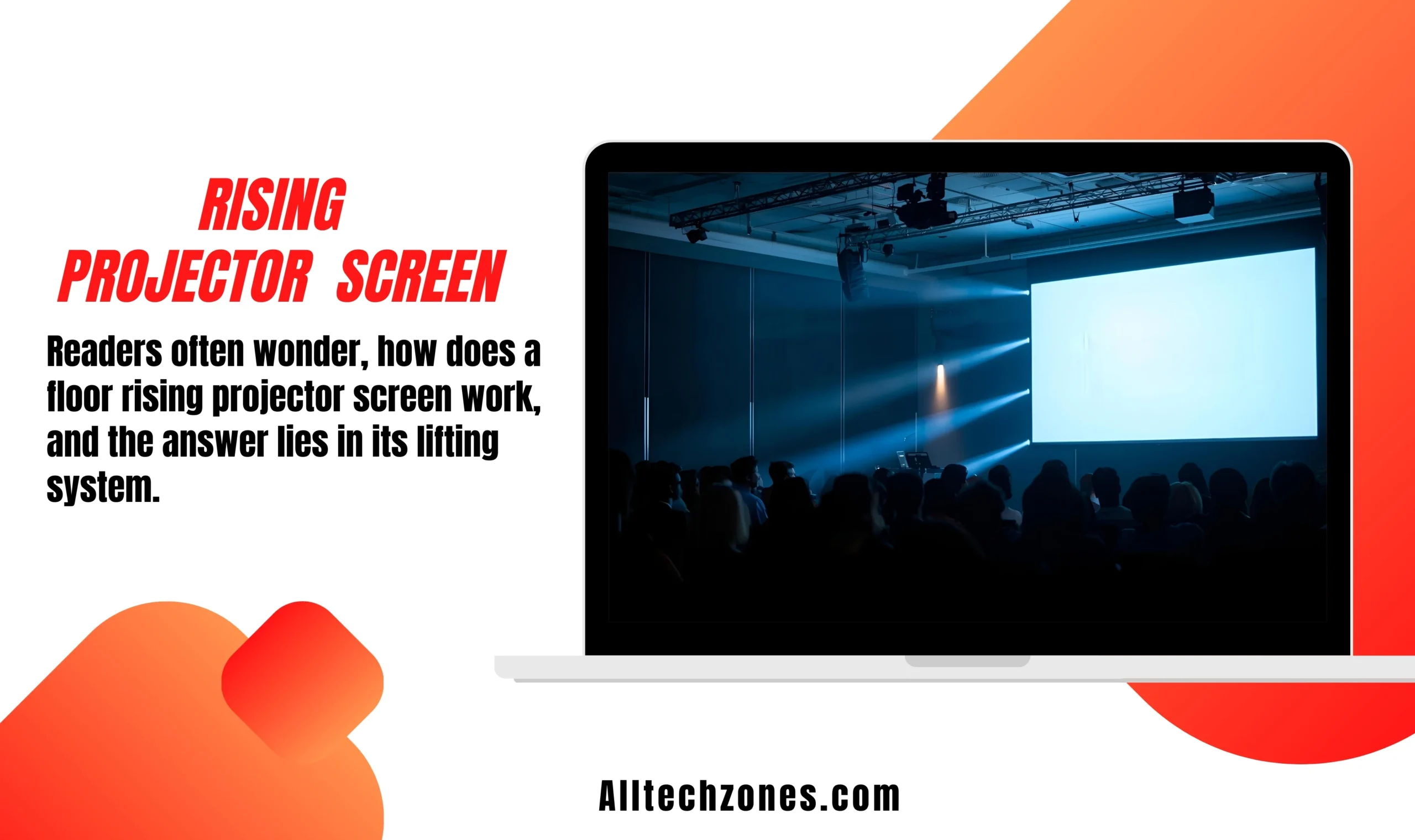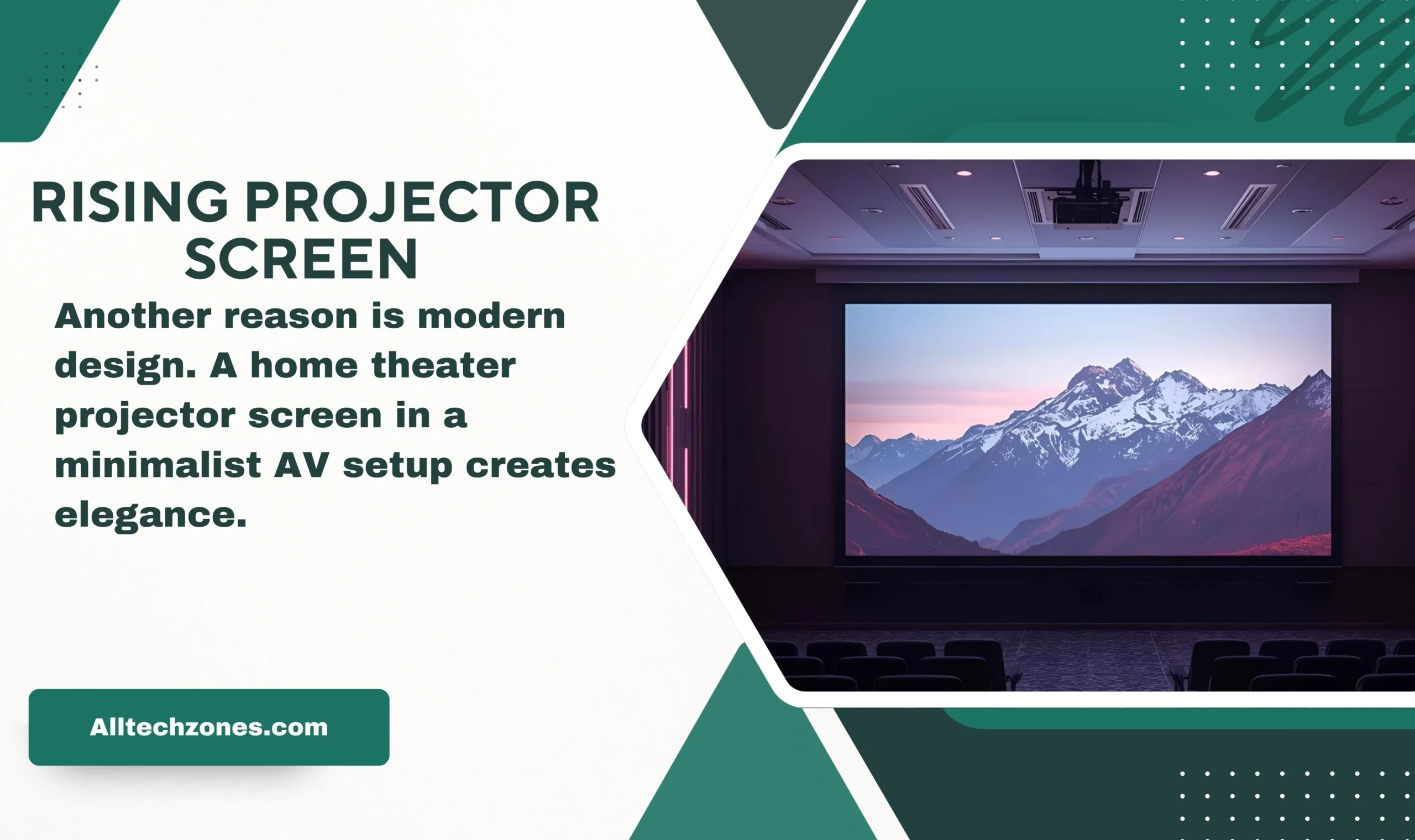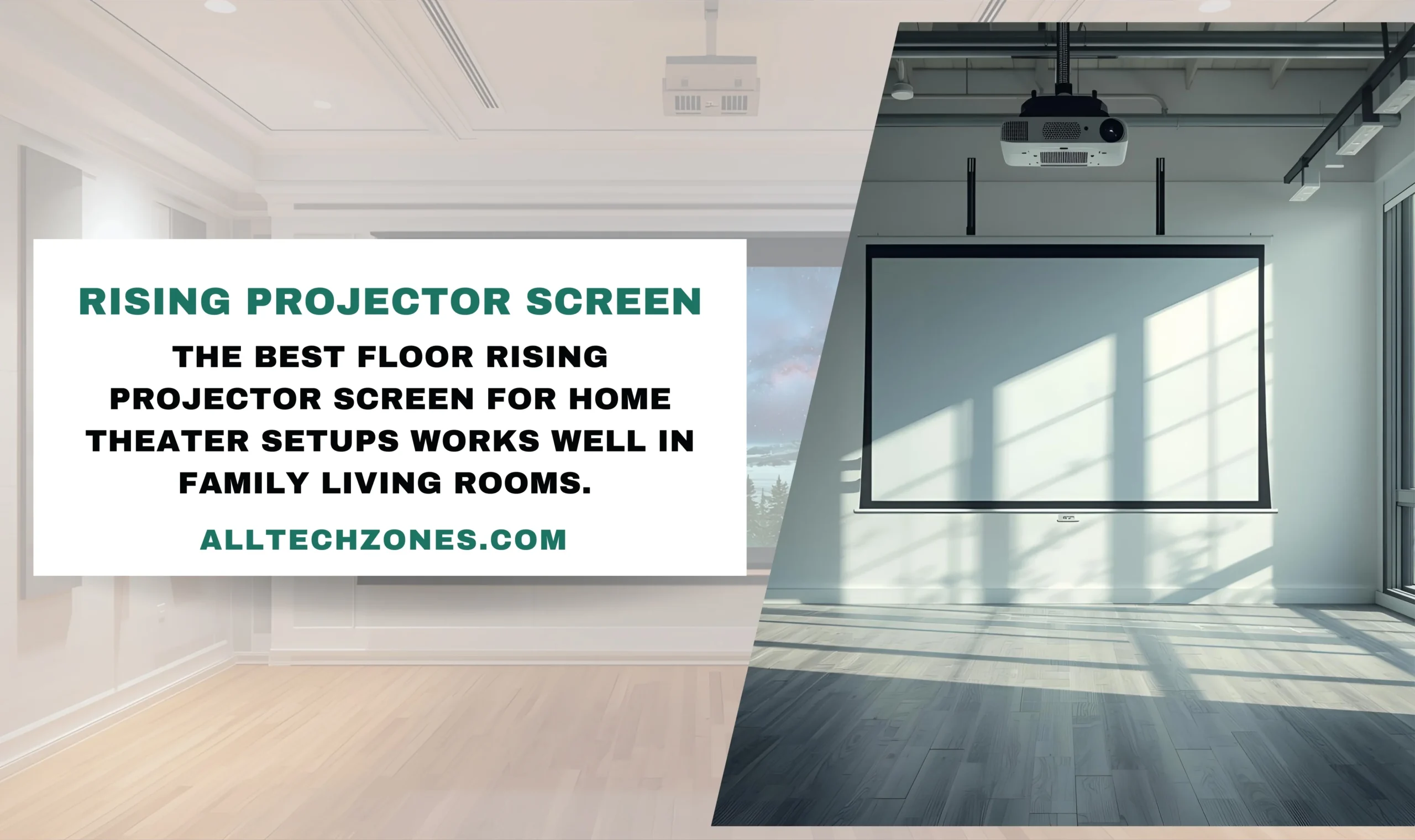Creating a cinematic experience at home no longer means drilling into ceilings or dedicating an entire wall to bulky equipment. The rising projector screen has transformed the way people in the U.S. enjoy movies, presentations, and gaming by combining elegance with functionality. Unlike traditional models, a floor rising projector screen stays hidden inside a sleek projection screen housing until you need it, then effortlessly lifts into place.
Whether you choose a manual floor rising screen for portability or a motorized floor rising screen for automation, the result is the same—big-screen visuals without permanent fixtures. Many modern homes now pair these screens with a home theater projector screen, creating immersive setups that match style with performance. For those who value space-saving design, modern technology, and seamless integration, this innovation represents a smart choice that blends everyday living with theater-quality entertainment.
What Is a Floor Rising Projector Screen?
A floor rising projector screen is a floor standing projector screen that comes out vertically from its base, also called a projection screen housing. Unlike traditional fixed screens that need permanent wall or ceiling space, this one stays hidden when not in use. People searching online often ask, what is a floor rising projector screen, and the answer is simple. It is a retractable projector screen that blends into a minimalist AV setup while still giving a cinematic view.
The key difference between a rising screen and other models is design flexibility. In homes or offices where wall drilling is not allowed, the advantages of floor rising projector screen setups are clear. They can fit inside apartments, heritage buildings, and even boardrooms. Because of this, they have quickly become part of luxury AV solutions in the U.S.
How Does a Floor Rising Projector Screen Work?
Readers often wonder, how does a floor rising projector screen work, and the answer lies in its lifting system. A manual floor rising screen uses a scissor-lift or gas spring to raise the fabric by hand. It is portable, lightweight, and ideal for moving between rooms. A motorized floor rising screen uses an electric motor that operates with a remote, wall switch, or even smart home projector integration systems.

Once the screen is raised, it locks in place, creating a flat viewing area. Premium models feature tensioned projector screen technology that keeps the surface smooth. This ensures crisp visuals for both movies and business presentations. The difference between motorized and manual projector screen models is mainly convenience. Motorized types cost more but are part of designer AV environments that demand automation.
Types of Floor Rising Projector Screens
When choosing the best floor rising projector screen for home theater, you’ll find three main categories. The first type is the manual floor rising screen, which is affordable, easy to carry, and often used in classrooms or presentations. The second type is the motorized floor rising screen, built for high-end home cinema setup where luxury and automation matter. Finally, the ALR projector screen, also called an ambient light rejecting screen, is designed for bright rooms where sunlight or indoor lights can affect quality.
A portable projector screen fits well for temporary setups, while a UST projector compatible screen matches ultra-short throw projectors popular in American homes. Each option brings different benefits. For example, a teacher may prefer manual portability while a designer might choose an automated ALR model for luxury AV solutions.
Key Features to Look for in 2025
The rising projector screen guide for 2025 shows four features that every buyer should review. The first is screen size. In the U.S., 100 to 120 inches is common for living rooms, while boardrooms may need larger displays. Next is screen material. Modern fabrics include acoustic transparent screen materials that let sound pass through, making them ideal for setups where speakers are placed behind the screen.
Aspect ratio also matters. A 16:9 ratio suits movies and games, while 21:9 is used for widescreen films. Finally, durability and portability decide long-term value. A premium projector screen with reinforced housing and a tensioned projector screen surface will last years. For frequent movers, a portable projector screen with strong casing is the best pick.
Advantages and Disadvantages at a Glance
To decide is a floor rising projector screen worth it, you need to see the pros and cons of floor rising projector screen designs. Below is a simple projector screen comparison table (fixed vs drop down vs floor rising) for quick review.
| Feature | Floor Rising Screen | Fixed Frame Screen | Ceiling Drop-Down Screen |
| Installation | Easy, no drilling | Permanent wall mount | Requires ceiling cavity |
| Aesthetic Integration | High, blends into space | Visible frame | Hidden but needs structure |
| Portability | High | None | Low |
| Screen Flatness | Excellent (tensioned) | Excellent | Good |
| ALR Compatibility | Yes (premium models) | Yes | Yes |
| Motorized Option | Yes | No | Yes |
The table shows why U.S. buyers choose floor standing models. A floor rising vs ceiling mounted projector screens debate usually ends with portability and design freedom being the winning factors.
Why Should You Choose a Floor Rising Projector Screen?
For many Americans, space is a priority. In apartments or shared living rooms, the projector screen for small apartments or limited wall space must be compact. The floor rising projector screen works because it hides away when not in use, leaving the room stylish. It is perfect for projector screen for architecturally sensitive buildings where drilling is not allowed.
Another reason is modern design. A home theater projector screen in a minimalist AV setup creates elegance. For event managers, the portable floor rising projector screen for presentations ensures mobility. These options explain why more projector screen for luxury AV buyers now focus on floor rising solutions.

Installation and Setup Guide
The floor rising projector screen setup guide is simple compared to permanent mounts. First, place the housing on a level floor. For manual versions, pull the bar to raise the screen until it locks. For motorized models, plug into power and press the remote button. Some U.S. brands also allow app control as part of smart home projector integration.
The easiest projector screen to install without drilling is the rising type. No screws, no ceiling brackets, no holes in walls. A renter in New York can use it without risking their lease, while a homeowner in California can combine it with smart lighting to create an instant theater effect.
Maintenance and Care Tips
Like any technology, these screens need care. Many readers ask, how to maintain a motorized projector screen, and the answer includes cleaning and storage. Wipe the fabric with a soft cloth and avoid harsh cleaners. Dust the projection screen housing regularly to keep motors free of debris.
For long life, retract the screen when not in use. A tensioned projector screen will resist curling, but proper care extends its life. Owners of premium projector screens often schedule light servicing every two years to ensure motors run smoothly.
Things to Consider Before Buying
Before buying, think about budget. Entry-level manual floor rising screen models cost far less than automated versions. For large homes, the best projector screen for modern minimalist homes may be motorized ALR with remote control. Room dimensions also matter, especially ceiling height for full extension.
Check compatibility with your projector. If you use ultra-short throw, you need a UST projector compatible screen. Another key point is after-sales service. Many premium projector screens in the U.S. come with 3- to 5-year warranties. Choosing a brand with strong local support ensures peace of mind.
Best Use Cases for Floor Rising Projector Screens
The best floor rising projector screen for home theater setups works well in family living rooms. A couple in Chicago, for example, may not want to drill their newly painted wall. Instead, they use a retractable projector screen that rises when movie night starts.

In education or business, a portable floor rising projector screen for presentations is often used. Offices in San Francisco deploy them in boardrooms to maintain a clean look between meetings. Event planners in Miami rely on ambient light rejecting screen models for outdoor weddings and conferences.
FAQs About Floor Rising Projector Screens
What is a floor rising projector screen?
A floor rising projector screen is a retractable projector screen that lifts vertically from a compact base. It offers a clean look with no wall or ceiling installation. Perfect for minimalist AV setups and luxury AV solutions.
How does a floor rising projector screen work?
It works by using either a manual scissor-lift or an electric motor to raise the fabric. A manual floor rising screen is portable, while a motorized floor rising screen connects to remotes or automation. Both lock in place for a smooth viewing surface.
Which projector screens work with UST projectors?
The best option is a UST projector compatible screen designed for ultra-short throw projectors. Many models use ALR projector screen fabrics to reduce ambient light. These give sharp, bright images even in open U.S. living rooms.
Is a floor rising projector screen worth it?
Yes, because it combines flexibility, portability, and modern design. The advantages of floor rising projector screen setups include easy installation and sleek looks. They are ideal for renters, homeowners, and businesses.
Can it connect to smart homes?
Yes, a floor rising projector screen with smart home integration works with Alexa, Google, or Crestron. Motorized models can sync with lights, sound, and automation scenes. This makes it part of a full designer AV environment.
Final Thoughts + Quick Comparison Table
The rising projector screen guide shows how this technology meets modern needs. It is flexible, elegant, and practical. When comparing floor rising vs ceiling mounted projector screens, the rising option wins for portability and design. Below is a final projector screen comparison table (fixed vs drop down vs floor rising).
| Feature | Floor Rising | Ceiling Drop-Down | Fixed Frame |
| Portability | Yes | No | No |
| Ease of Setup | High | Medium | Low |
| Style | Minimalist | Traditional | Visible Frame |
| Price Range | Mid to High | High | Low to Mid |
In short, the advantages of floor rising projector screen models are clear. They bring high-end home cinema setup experiences to U.S. living rooms without permanent changes. For those who love designer AV environments, this is the future. Whether you are a renter, a homeowner, or a business owner, investing in premium projector screens ensures a theater-quality experience with ease.
For More Amazing Information Keep Visiting AllTechZones.
